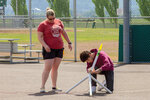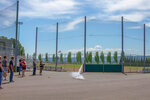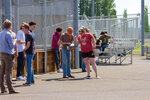


Math teachers at Woodland High School have been using innovative hands-on experiments to engage students and enhance their learning.
Applied Math is a class that goes beyond traditional math instruction, according to a press release by Woodland Public Schools.
“(The class) continues to gain recognition for its ability to bridge the gap between theoretical concepts and real world applications,” according to the release. “Through hands-on experiments and practical projects, high school students enrolled in Applied Math explore mathematical principles in a tangible and engaging way.”
Applied Math implies algebra and geometry concepts to hands-on, real-world experiments to take those concepts into reality.
“Applied Math provides the ‘why’ to back up the equations and concepts students have learned in prior years,” Jennifer Benedict, a math teacher at Woodland High School, said in the release. “The chance to see principles in action makes concrete connections to concepts that may have been abstract prior to the hands-on experiment.”
For their projects, students write reflections addressing mathematical principles and concepts they observed in their real-world experiments.
“These reflections provide students the opportunity to practice math literacy as well as math writing skills,” Benedict said in the release. “Students practice data analysis and interrupt patterns that may happen between testing and data collection.”
Throughout a semester, projects will take students through the engineering design process. Applied Math gives students a Career and Technical education credit. The class invites guest speakers, from a variety of backgrounds, present to students throughout the year.
Benedict said in the release that her course work stems from engineering 100 and 101 courses written for the Air Force Academy, a robotics section developed alongside one of her contacts from NASA’s Jet Propulsion Laboratory, and content from her own experiences.
“The collaboration with all of my sources has been instrumental to the success I’ve had with this class as my contacts help me deepen my engineering knowledge so I can better share the concepts with students,” Benedict said in the release.
The course’s adaptability allows teachers to meet students where they are, enabling a more personalized instruction and educational support, according to the release. The inclusivity fosters an environment where students can thrive, regardless of their mathematical abilities, prior knowledge or individual learning styles, the release stated.
Benedict was influenced by teachers and family members to become a math teacher.
“For me, it was a case of nature and nurture as my parents are an engineer and an accountant. The love for school and STEM subjects was passed on to me,” she said in the release. “I was also lucky to grow up in a school system that allowed great teachers to be great. This resulted in me wanting to be a teacher for my whole life, and Applied Math gives me the chance to help pass on my excitement for learning and to encourage curiosity in my students.”